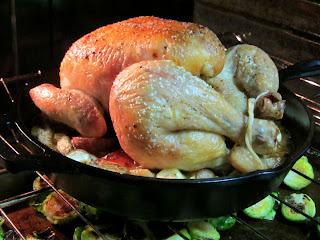Another time, when I was in Germany I went to get my hair cut and colored. I had an idea for what I wanted but surprisingly, “A trip to the Hair Salon” was not one of the vocabulary units we studied. After muddling through what I wanted, the hair stylist nodded and said no problem. Many highlight foils and a good hour and a half later, she took out everything from my hair and called another stylist over for consultation. I had not yet seen my hair in the mirror. After some whispers – they both told me it looked awesome. I was dubious. I wound up with three very distinct highlight chunks on my head – white, brown and copper. It was pretty shocking. However, I did not, for the life of me, know how to tell her anything besides how awesome it was. I finally determined that my hair was pretty cool; cooler than me, so I would just have to pretend.
And the other time shopping in a foreign language has left me with deleterious results was also in Germany. I was walking past the gypsy farm stands behind my dorm and saw a very good price for fresh spinach. I figured, why not. Now, the price for spinach was by the kilogram. When asked how much spinach I wanted, I froze. Extreme panic set in as I scrambled to try and remember what the other delineations of metric weight were. There are milligrams, centigrams, decigrams, grams, something, something, kilograms. I had literally no idea how much spinach I wanted nor did I know what measure I should use in the purchase. So I told the gypsy ‘Ein Kilo’ – one kilo. That is a lot of spinach. After cramming a plastic shopping bag full of spinach he looked at me and told me it wasn’t quite a kilo, and did I want it anyways. I nodded yes. (Similar to my tomato experience this summer). I completely forgot that I could order the spinach the EXACT SAME way I do here – half a kilo, a quarter kilo, all would have worked just as well. And if I had managed to remember hectogram I’m sure the gypsy would have thought I was even more crazy.
So in honor of accidentally ordering way too much spinach, I would like to share the following recipe with you.
A friend of mine made this last winter, and I have been mildly obsessed with it ever since. The original recipe is a bit different and calls for more ingredients. Personally, I like this simple version and I don’t think you miss out on any flavor.
As adapted from Martha Rose Shulman, New York Times
1 box frozen chopped spinach, thawed
1 ¾ c water, divided
1 small onion, diced
1 Tb olive oil
3 cloves garlic, minced
1 c quinoa, rinsed if necessary
Salt
In a blender or food
processor, combine spinach and ¾ cup water and puree. There will still be some chunks of spinach,
but as long as it is mostly liquefied, it will be fine.
In a medium saucepan over
medium-high heat, sauté the onion in the olive oil until translucent, about 5
minutes. Next add garlic, quinoa and a
pinch of salt. Sauté about 3 more
minutes, stirring constantly to toast the quinoa. Add in remaining one cup of water, bring to a
simmer, cover and cook for about 5 minutes.
Next add in the spinach puree, and another pinch of salt. Bring to a simmer, cover and cook for about 15
to 20 minutes, or until the quinoa is cooked and the liquid is absorbed. Fluff with a fork , check for seasonings and
serve.



















